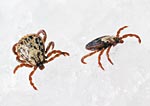  |
| HOME | THIS ISSUE | CALENDAR | GRANTS | BACK ISSUES | < BACK | NEXT > |
Ticks’ tactics for spreading disease are focus of Health Center studyby Carolyn Pennington - July 24, 2006 |
||||
| Barely bigger than a freckle, ticks are responsible for millions of cases of human suffering every year. After the tick's microscopic mouthparts pierce the skin, dozens of diseases, some potentially fatal, can be injected into its victim's blood stream. Despite the revulsion you may feel when you find a tick crawling up your leg or nestling behind your ear, they deserve some respect. Complex creatures
These unique characteristics make the tick a formidable foe, and there's a battle afoot to disarm it. Leading the offensive is Stephen Wikel in the Health Center's Department of Immunology, one of the leading tick researchers in the world. "When I first started studying ticks more than 30 years ago, I didn't grasp their complexity," says Wikel.
Wikel takes great pride in the colonies of the tiny creatures he has amassed. "We maintain colonies of every medically important hard tick species in North America," he says. He even has some "pure-bred," pathogen-free ticks that are sought after by researchers across the country. Studying saliva But deciphering what makes ticks "tick" could lead to a vaccine that might someday take the worry out of a walk in the woods. "The tick is an amazing arthropod," says Wikel. "Basically, its nose is in its feet." Its olfactory system recognizes carbon dioxide from animals as they exhale. Ticks lie in wait for the carbon dioxide signals and temperature clues that indicate a meal is nearby. They're not picky eaters: they'll feast on people, pets, livestock, reptiles, and birds. They need blood to grow from egg to adult, and the adult female needs blood to nourish her eggs. Ticks spread disease by taking blood from an infected animal and then feasting on another animal. Females can pass infectious agents into the eggs they produce, perpetuating the infection into the next generation. Globally, they are second only to mosquitoes in transmitting diseases to humans, and they are the most important transmitter of diseases to animals. They transmit a diverse array of viruses, bacteria and protozoa. In fact, many of the microbes included on the Center for Disease Control list of Select Biological Agents and Toxins are transmitted by ticks. The diseases caused by these agents are a major bio-terrorism concern, because of their potential to be introduced into the country and infect ticks. Wikel believes the bio-terrorism risk is real. He says West Nile virus is an example of an infectious agent that was introduced into the country and efficiently transmitted by existing mosquito species.
"If you could take a tick and infect it with hemorrhagic fever or encephalitis - diseases that have high fatality rates - no one would want to step foot outside," he says. Genetic clues A primary interest is Ixodes scapularis, better known as the deer tick. This little creature is the main vector of Lyme disease, the most commonly reported tick-transmitted human disease in the United States. It can cause lethargy, joint swelling, and facial paralysis, and lead to chronic arthritis and neurological syndromes. The tick also transmits encephalitis and babesiosis, a malaria-like illness. Wikel is helping unravel the complexity of this infamous tick as part of the Ixodes scapularis Genome Project (IGP) with researchers at Purdue University, the University of Notre Dame, the Institute for Genomic Research, and the Massachusetts Institute of Technology/Harvard University. The National Institutes of Health are funding the project. Despite its minuscule size, the deer tick has a genome two-thirds the size of a human genome. So far, researchers have successfully sequenced more than half the genome. "This is the first time researchers have explored a tick genome in depth," says Purdue's Catherine Hill, co-principal investigator for the project. "It's crucial to learn how ticks spread serious illnesses because of the global health threats these diseases pose." When it comes to their genes, ticks have a lot of redundancy. Just as our bodies have developed numerous ways of clotting blood so wounds can begin to heal, ticks have developed multiple ways of stopping our blood from clotting so they can keep feeding for days. "Instead of just having one gene responsible for a certain task, there's a whole family of genes that have been duplicated to do the same thing," says Wikel. "Millions of years of evolution have given them creative ways of getting around our immune systems and other defenses such as blood clotting, pain responses, and wound healing." The detailed molecular information developed from the genome project will provide tick researchers with targets for developing insecticides and other tools for disarming ticks. For example, by identifying the genes active in tick saliva, Wikel believes they can enhance work aimed at developing a vaccine that will specifically target the molecules responsible for helping the tick feed and transmit disease so successfully. "Developing vaccines that target each possible tick-borne disease is not realistic from a scientific perspective, nor commercially feasible," says Wikel. "But developing a vaccine that responds to tick saliva would have great value because it could work against more than one tick-borne disease." And because ticks typically have to feed for hours before they start transmitting disease-carrying bacteria, there is a window of opportunity. "It gives us a chance to disrupt the cycle, a point where a vaccine may be successful," Wikel adds. He says there's still a long way to go before such a vaccine becomes a reality: "There are still a lot of unknowns, lots of blanks that need to be filled in. Completely understanding this complex creature will take time." |
| ADVANCE HOME UCONN HOME |

 A growing admiration for their intricacies helps fuel an obvious enthusiasm for his job. In his spare time, Wikel will tuck his pants into his socks, wrap duct tape "sticky side out" around his ankles, and take a walk through his wooded back yard to snare some unsuspecting ticks.
A growing admiration for their intricacies helps fuel an obvious enthusiasm for his job. In his spare time, Wikel will tuck his pants into his socks, wrap duct tape "sticky side out" around his ankles, and take a walk through his wooded back yard to snare some unsuspecting ticks. 